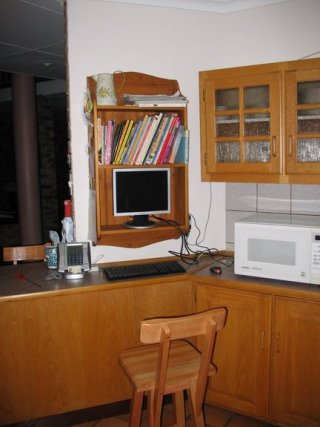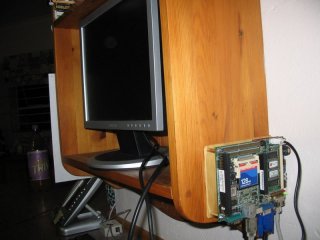In the kitchen?
A PC in the kitchen... whatever for? We often get people over who has the need to "use the internet". Then I take them into the study and they use my PC. Afterwards, I find that:- some bookmarks was created
- windows was moved around
- stuff downloaded onto my desktop of all things!
Enter my friend the IB300. We used them on some projects at the office, but have since replaced them with a difference SBC (SingleBoardComputer). I was able to put my eager little hands on one and started playing.
Parts
The parts that I used:- 1x IB300
- 1x 128Mb RAM
- 1x 128Mb compactflash (used to be in the digital camera, but that was upgrade to 1Gb)
- 1x 5V powersupply (thanks Tiaan)
- 1x standard 15" LCD screen (thanks for the donation Tanya! Proving again that you love me more than most...)
- 1x USB keyboard
- 1x USB mouse
- a couple of M3 standoffs and allencap screws
- some CAT5 for the network connection
- 1x Linux machine to be the terminal server
Step 1
The Linux server was already up-and-running with FC4, so I just installed the LTSP software (version 4.2). For this I pretty much followed the installation instructions as supplied. The one thing that was a bit hard, is to get your DHCP server to work with you. Mine happen to be Dnsmasq running on a OpenWrt-enabled Linksys WRT54G. Here is the config that I added:dhcp-vendorclass=pxe,PXEClient
dhcp-vendorclass=eth,Etherboot
dhcp-boot=net:pxe,/lts/2.6.17.3-ltsp-1/pxelinux.0,pion,192.168.22.2
dhcp-boot=net:eth,/lts/vmlinuz-2.6.17.3-ltsp-1,pion,192.168.22.2
dhcp-option=17,192.168.22.2:/opt/ltsp-4.2/i386
dhcp-option=48,192.168.22.2 # font-servers
dhcp-option=49,192.168.22.2 # x-display-manager
dhcp-option=66,pion # tftp-server-name
Here is the config from lts.conf
[Default]
SERVER = 192.168.22.2
XSERVER = auto
X_MOUSE_PROTOCOL = "PS/2"
X_MOUSE_DEVICE = "/dev/psaux"
X_MOUSE_RESOLUTION = 400
X_MOUSE_BUTTONS = 3
USE_XFS = N
SCREEN_01 = startx
SCREEN_02 = shell
[192.168.22.118]
X_MODE_0 = 1024x768
X_MODE_1 = 1024x768
X_VERTREFRESH = 60
SCREEN_01 = startx
SCREEN_02 = shell
Step 2
The IB300 runs of 5V DC. The power supply I could get had strange "uk/euro" (not sure which) plug and I was not able to get a real adapter for it. With some soldering, a couple of short cables and plenty help from the glue gun I ended up with this:Step 3
I needed to get the IB300 to boot from a local device. This is where the compact flash comes in. With Slackware it is very easy to do a bare-as-you-can-get installation. Now I download a zlilo image from magic and add that into the lilo config. In the end I do not use any of the local installed Slackware software except for LILO to do the boot.note to go and get the LILO config file to show here...
Step 4
At last I can assemble the entire "PC". I use the standoffs to make a little platform on which the IB300 is mounted. This platform is then fixed to the side of the bookcase. You can see some photos of the final result here..


Notes...
- It takes about 90seconds from poweron to login prompt.
- The only noise is a single BEEP on startup (and it rarely reboots!)
- Need to get the sound working under LTSP. This will enable me to also replace the CDplayer in the kitchen by playing mp3's on here.
- I have a TV-tuner card in the Linux server: how to stream the FM radio here? More toys!
- Still need to do some cleanup of the cables!
No comments:
Post a Comment